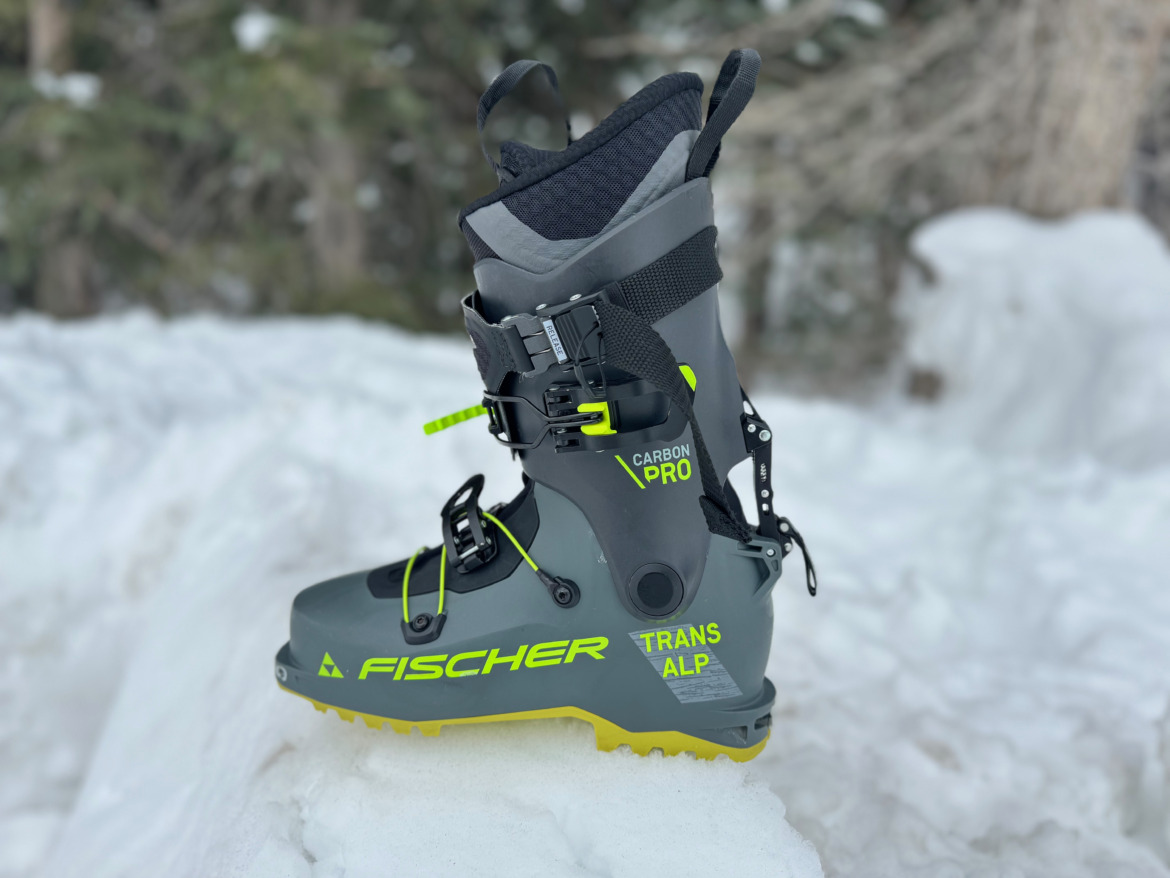
Snow conditions have been wild this season. I’ve wallowed through waist-deep powder, struggled through breakable crust, skied a lot of ice, sloshed around in corn, and encountered everything in between. I’ve found a reason to bring out every ski in my quiver which means a range of skis and conditions for testing touring boots.
The new 2024 carbon-cuffed Fischer Transalp Pro Ski Boots ($999.99) are poised to replace the Pebax RNew Transalp Pros that have been around for several years, but the overall chassis remains the same. Like their predecessor, the new boots are streamlined – two buckles, power straps, and integrated gaiters. There’s a lot here to like in a lightweight, aesthetic package.
I’m not afraid to haul a little extra ski and boot uphill if and when it translates to more fun. Sure, I love ripping a bunch of laps on my super light setup, but there’s a place for big skis and big boots too. I had to double-take when I saw Fischer’s new Transalp Carbon Pro touring boots’ advertised 1,280g weight. I had assumed, given how powerful they look, that they were much heavier. Could they be enough boot to lighten my big ski setup? One boot to drive my full ski quiver? (The short answer is: yes. Read on for the long answer.)

The 1,429-gram Fischer Transalp Carbon Pros aren’t a chore to lug uphill.
Specs
Price: $999.99 at evo.com
Weight: 1,429g (27/27.5)
Last Width: 100mm
Shell Material: Pebax Rnew
Cuff Material: Pebax Rnew reinforced with carbon fiber
Power Strap: Camming power strap with quick-release
Sole: Full rubber rockered
Binding Compatibility: Tech, MNC
Range of Motion: ~80°
Skiing the Transalp Carbon Pro
I threw my entire arsenal of skis, as well as a few demo skis, under the Transalp Carbon Pros in nearly every snow condition over the last few months – 191cm 4FRNT Hoji’s, 189cm Kastle TX103’s, 186cm Volkl Blaze 106’s, 178cm Black Crows Orb Freebirds, and 176cm Fischer Transalp 92 CTI’s. I’m 185cm tall, 85kg for reference.
It’s been a fun ride. I’ve been impressed by how capable the Transalps have been across that spectrum. They handled each of those skis without feeling over- or underpowered. I’ve loved the lightweight Scarpa F1 XT’s and La Sportiva Skorpius CR II’s, but frankly, they don’t have that kind of versatility.
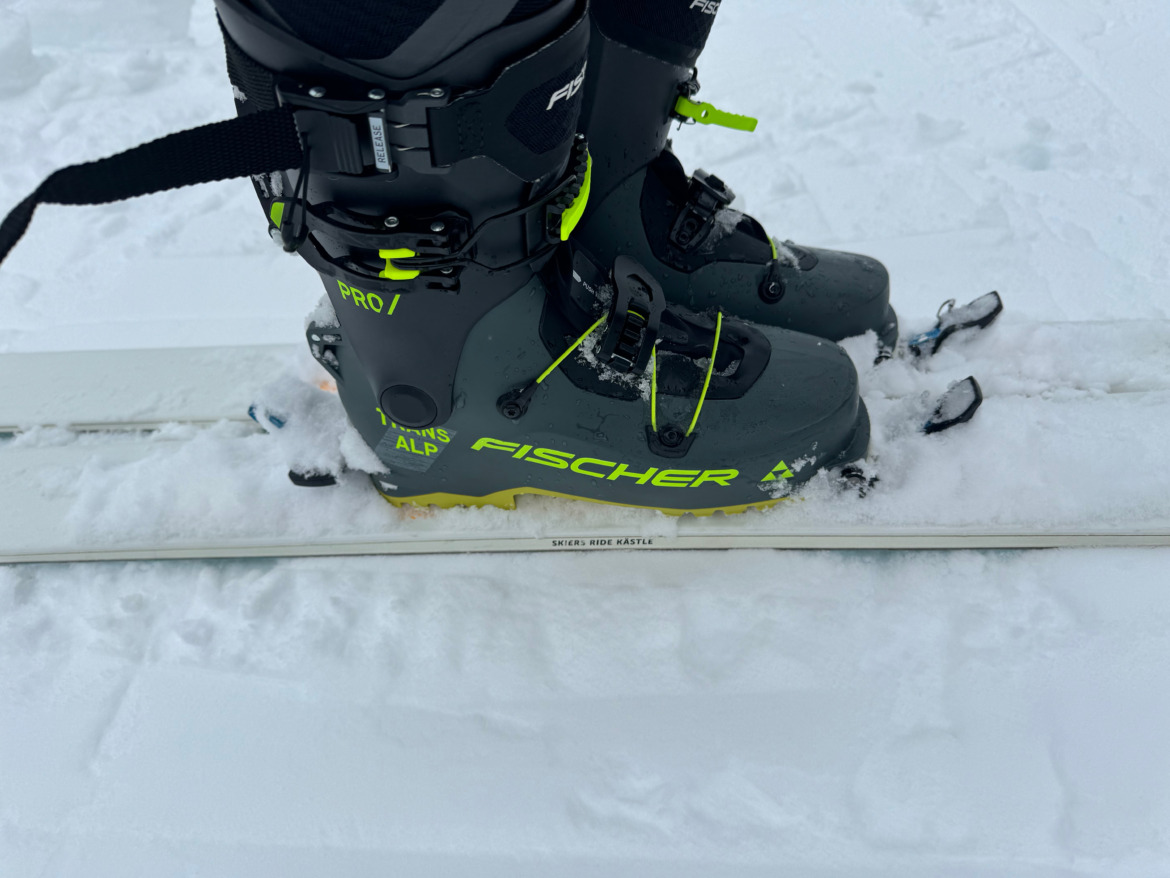
A simple two-buckle setup with cam-strap power strap.
The Transalp Carbon Pros aren’t what I’d consider freeride touring boots like the 1,631g La Sportiva Vanguard (28.5), nor do they ski delicately like the weight class below them. They’re right in the middle. I wasn’t itching for more support and power like I do in my Scarpa F1 XT’s with big skis in some snow conditions, nor did they inspire me to charge at my limit.
Their 130 flex claim is generous – I’d place them in the 120 flex realm and that’s not a knock. It’s honestly a friendlier ride than most carbon boots. The cuffs are stiff given the carbon-reinforced Pebax Rnew, but the Pebax Rnew shells deform readily. They don’t fold, but they’re relatively soft off the top and ride deeper into the flex range than other carbon-cuffed boots I’ve been on. They’re decently progressive, too. I didn’t feel like I could push past the progressive ramp up in any typical skiing situations like I find myself doing from time to time on lighter boots.
My mid-width, mid-weight TX103’s were the best match for the Transalps, but I was impressed at how well they drove 112mm wide 4FRNT Hoji’s in soft snow. That helped keep the overall weight of my setup with those 2066g skis reasonable for longer days even though a heftier boot, like my La Sportiva Vanguard, adds a little more muscle behind them. On the flip side, they didn’t overpower or feel mismatched on smaller skis like the Transalp 92 CTI.
Touring in the Fischer Transalp Carbon Pro
At a verified 1,429g each in the 27/27.5 size (liners plus shells, sans footbed and spoilers), the Fischer Transalp Pros weigh in just below the 1,500g mid-weight boot threshold right near Tecnica’s 1,416g Zero G Tour Pros (27.5).
That lands them right between mid-weight touring boots like Scarpa’s 1,500g Maestrale RS’s (28) and lightweight boots like Scarpa’s 1,267g F1 XT’s (27.5) and La Sportiva’s 1,285g Skorpius CR II’s (28.5).
Fischer claims 80 degrees of cuff rotation and I confirmed it with the liner out. But unsurprisingly, that’s not exactly the case when you stuff a liner, foot, and ankle in there. On the skin track, the forward flex felt generous and I wasn’t wishing for any additional articulation, even while pushing straight up steep runs on the resort. The movement was low-friction, too.
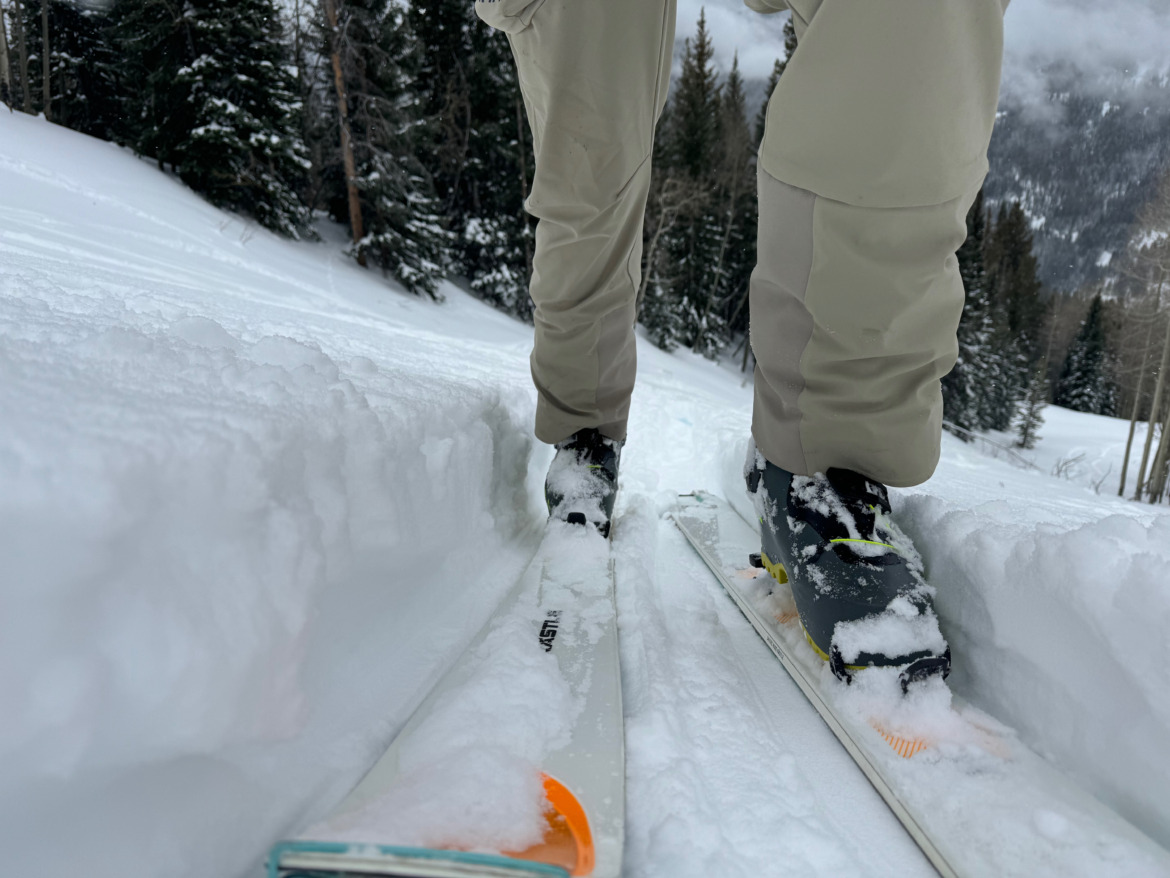
The rearward articulation wasn’t quite as generous. There wasn’t a hard stop, but the articulation was limited sooner than when my ankle would have maxed out. It seemed more a function of a higher shell behind my heel and lower Achilles than rotation of the actual cuff. I noticed it on long, flat sections of skin track and packed roads where I was able to take much longer strides. It never bothered me uphill or in my typical backcountry zones, which are characterized by pronounced ups and downs rather than a lot of flats, traversing, and fire roads, but it’s worth noting nonetheless.
Apart from the awful keeper springs (more on that later), I thoroughly appreciated the fuss-free transitions. There’s no velcro to deal with, only two buckles, a satisfying ski/walk lever, and an excellent camming power strap. Simple, quick, and solid.
Fit and sizing
My feet are the worst. I have exceptionally high arches, small tailor’s bunions, and hammer toes, but at least they’re average width. I’ll be honest, I dread putting these boots on and taking them off. At one point, standing in a snowy parking lot trying to jam my left foot into the boot, I thought I might need to bail on the hut trip I was suiting up for. I was literally speculating if I could hike the 2.5-mile approach in my Blundstones.
The situation improved over time as the liners broke in, but my feet straight up aren’t going in there if the shells freeze. The carbon-infused cuffs are stiff. Even after rotating the cuff fully out of the way, there’s a lot of shell to get past.
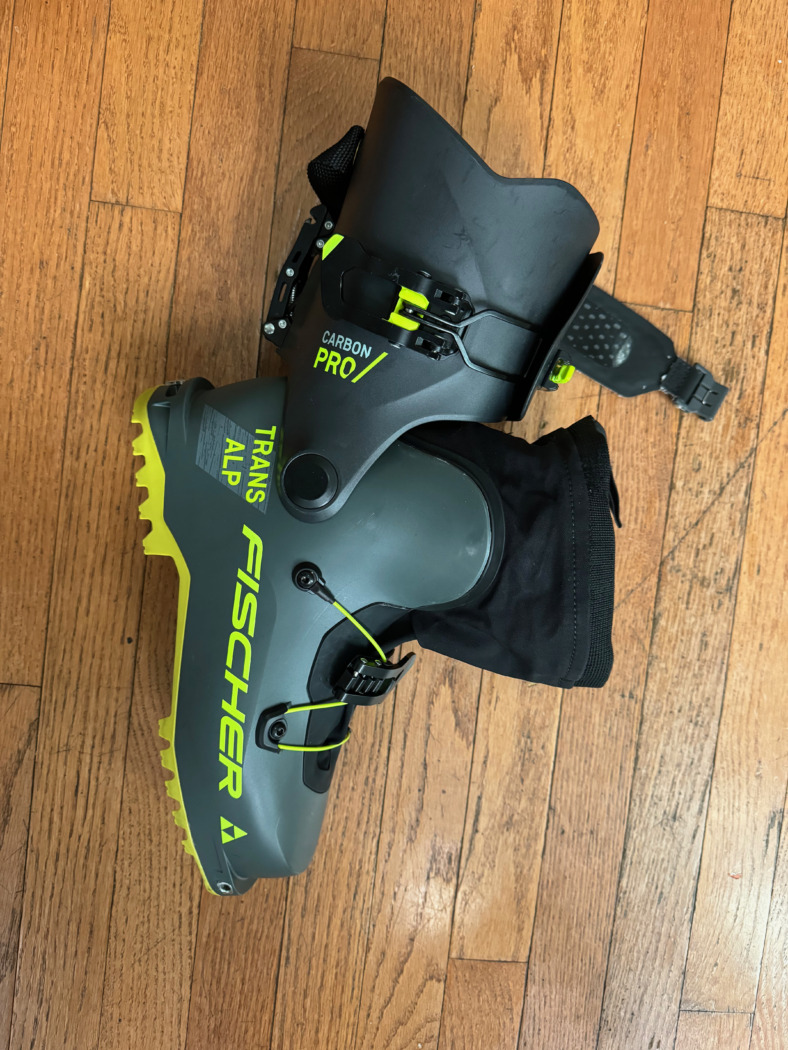
The Transalp Carbon Pro technically has an 80-degree range of motion. but
Once I get them on, I like the fit a lot. Their 100mm lasts accommodate the widest part of my forefoot and feel somewhere between a medium and low volume fit. The heel hold is excellent and this is the first pair of touring boots that I haven’t immediately added heel shims to. I have yet to get a blister – nothing about the fit feels sloppy and that’s a big win.
Fischer didn’t skimp on liners to hit their weight target. Mine came in at 314g each without the rear spoiler (35g each) and footbed. They’re sturdy and I appreciate the dense ankle guards that protect my sensitive ankle bones.
The bases of each liner are covered in a sheet of what looks like a lightweight waterproof and abrasive outsole – ostensibly for walking on snow or the floor of a hut. Would my slippers get the axe on a hut trip or winter camping? Hut trip, yes. That’s easy weight/space savings in my pack. Camping? I honestly don’t think I’ll be able to take these boots winter camping – as I alluded to before, if these shells freeze, my foot isn’t getting in.
Buckles
I’m a big fan of buckles over BOA on touring boots and the Transalp Carbon Pros do a lot with two simple buckles. The lower buckle utilizes an equalizing z-cable similar to Scarpa’s Maestrale and F1 XT. It does a good job of dispersing the tension over the forefoot. Because my foot wasn’t sliding around in the boot while touring, I tended to leave that buckle open while touring. I was pleasantly surprised that I die from top-of-the-arch pain when I did lock it down for skiing.
I appreciated the top buckle’s throw. It was easy to get the tightness I needed quickly and without any leverage-building yoga moves. They dispersed the tension across the cuff well, too. Combined with the cam-style power strap, the cuff closure tension is excellent. This is subjective, but I felt virtually no dead space inside the boot when locked and buckled into ski mode, and they were genuinely pain-free and comfortable.
The upper buckles do not have any kind of micro-adjustability, however, nor are there additional holes to move the buckle’s bale section and ladder section farther apart on the cuff. That hasn’t proven to be an issue for me yet, but I’m nearly maxed out. If the liners pack out much more I may drill an additional hole in the cuff. Thankfully the boots do come with velcro spoiler pads that eat up some additional volume and change the angle slightly. Skiers with particularly narrow calves and ankles should take note.
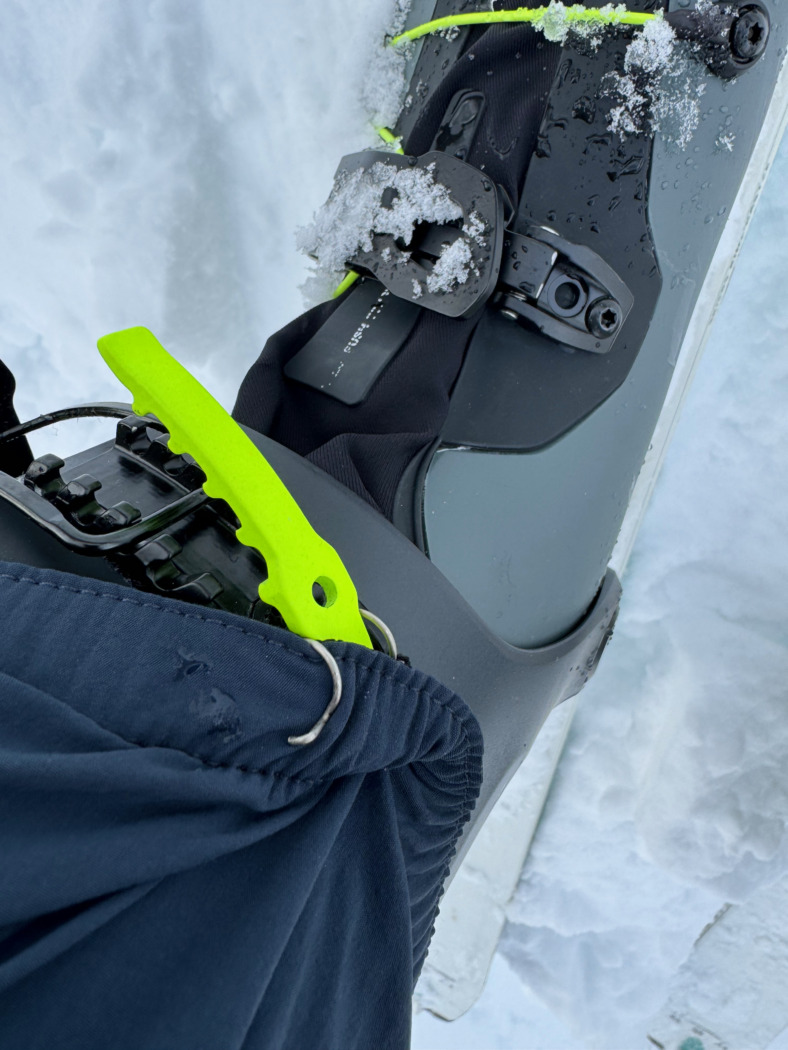
An annoyance caused by protruding spring ends, ripe for aftermarket engineering.
Out of the box, I liked the wire keeper on the upper buckle (bright green). It did not, however, continue to impress me. The spring mechanism at the joint, which allows you to open and close the keeper, has metal ends that snag on my pants every time I lower the inner gaiters over them (see photo below). The snag pulls them out of their tracks and it’s not the easiest thing to put back in by hand without pliers. It’s a relatively small issue, but I’ll probably end up removing the springs entirely and engineering a better solution in classic Wildsnow fashion.
Ski/Walk Mechanism
The ski/walk mechanism is simple and well-executed. The Transalp relies on a vertical spring-loaded lever mounted to the rear of the cuff that hooks to a bar on the rear of the shell. What is unique is the hook’s spring-loaded locking mechanism that grabs and locks around the bar. It can only be released by pulling the short nylon tab mounted at the bottom of the lever.

The hook’s spring loaded locking mechanism that grabs and locks around the bar.
The lever also integrates a flippable chip to adjust the forward lean between 16° and 13°. The whole mechanism has been rock solid so far and has not developed any play. I haven’t had any issues with snow buildup around the bar either. And as you’d expect from any touring boot, it has never opened erroneously.
Final Thoughts
Maybe it’s what I should have assumed given the impressive weight, materials, and buckle layout, but the Fischer Transalp Pros don’t fall neatly into a pre-established weight class. In terms of both weight and power, they’re right between ~1-1.2kg boots like the Scarpa F1 XT and La Sportiva Skorpius CR II and 1.5 kg+ boots like Scarpas’ Maestrale RS and Dynafit’s Radical Pro.
Unlike lighter boots, they paired well with all the skis in my quiver. I wasn’t left wanting more, especially with skis in the 95-105mm width range. They also didn’t feel like overkill when paired with my narrow and lightweight Fischer Transalp 92 CTI’s.
Aside from the minor buckle-keeper issue, my only real gripe with these boots is how challenging they are to get into with high arches like mine. If you’ve got low-profile feet that can get in and out of these boots easily, I’m jealous, because these are solid, lightweight all-rounders that can drive most backcountry skis and thrive in most conditions.
Buy the Fischer Transalp Carbon Pro Boots at Evo.com

Bergen Tjossem is a ski fanatic, conservation professional, and nature nerd based in Vail, Colorado. His life and career have centered around protecting the natural environment and public lands that raised him, but as Ed Abbey put it, “It is not enough to fight for the land; It is even more important to enjoy it.” So when he’s not working his day job, you’ll find Bergen ski touring before dawn, ice climbing in the dark, running trails until his legs fall off, skiing 13er’s with his friends, or making the world’s best pizza with his wife, Rachel. You can find him on Instagram.
